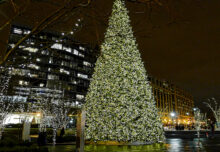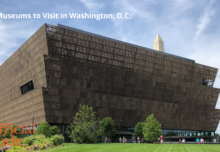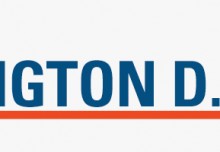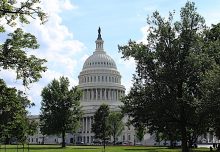Newseum—A Museum dedicated to journalism, reporting, and the role of the press in society

Reviewing the Newseum is essentially a review of modern news reporting: A core slice of it is excellent and reminds you that the Fourth Estate is vital to a functional democracy. The rest of it you’ve probably seen for free on the web.
The Newseum’s Today’s Front Pages exhibit, on Level 6, is an example. In its one long hallway hangs today’s full-color front page from 80 newspapers, including one from every US state and selected editions from around the world. Thirty years ago, this would have been an amazing display available only to large corporations with multimillion-dollar data and communications systems. Even today, it’s still impressive to look at. But we all know that those pages are less current than the newspapers’ own websites, which we get on our phones at zero cost.
That said, there are several excellent exhibits in the Newseum, many of which should provoke a discussion on the current state of news reporting, what its goals should be, and how news organizations should be paid for their work.
One of the best exhibits is Reporting Vietnam, also on Level 6. The media’s coverage of the war in Vietnam, especially the in-country television reporting, had a major influence on how Americans viewed the war. Television news wasn’t widespread for World War II or the Korean War, and negative stories about those conflicts were frequently censored or suppressed by either the US government or the news organizations doing the reporting.
Vietnam was different. It was covered by television crews delivering same-day footage of front-line battles, often sending images of wounded or dead soldiers and civilians directly to American living rooms during dinner. Those images evoked a more powerful antiwar sentiment than any text description could hope to attain.
 Another good exhibit is News History Gallery, on Level 5. This is a collection of more than 300 important newspaper front pages from the middle of the 15th century to today, covering events as they happened, from the American Revolution to the bombing of Pearl Harbor, the Kennedy assassinations, moon landings, and 9/11.
Another good exhibit is News History Gallery, on Level 5. This is a collection of more than 300 important newspaper front pages from the middle of the 15th century to today, covering events as they happened, from the American Revolution to the bombing of Pearl Harbor, the Kennedy assassinations, moon landings, and 9/11.
Another impressive hall is the Big Screen Theater, also on Level 5. This houses a series of huge video displays, each tuned to a different news source from around the world. On days with major stories, it’s interesting to see how each news organization covers those events. On slow news days, which happened when we visited, it becomes obvious that 24-hour news channels have to produce 24 hours of content, whether it’s all newsworthy or not. Regardless, you could easily spend half an hour here just catching up.
 A display worth seeing, on Level 3, is the 9/11 Gallery, a collection of newspapers, videos, and artifacts from the terrorist attacks in New York and Washington, D.C., on September 11, 2001.
A display worth seeing, on Level 3, is the 9/11 Gallery, a collection of newspapers, videos, and artifacts from the terrorist attacks in New York and Washington, D.C., on September 11, 2001.
Finally, stop by the Pulitzer Prize Photographs Gallery on Level 1 before you leave. As with the famous newspapers, you’ll probably recognize many of these iconic photos. What makes a visit worthwhile is the background stories about how each photo was taken.
Newseum Touring Tips
The Newseum’s suggested itinerary starts with the Concourse, one floor below the museum’s entrance on Level 1. From there you’ll take an elevator to Level 6 and work your way back down to the exit on Level 1. It’s a good touring strategy, and the one we recommend.
The Newseum is located on 555 Pennsylvania Ave. NW, Washington, D.C. 20001. The museum is open daily from 09:00 a.m. until 5:00 p.m.; closed on the 4th Thursday in November, December 25, and January 1. For more information visit the Newseum website.
For a review of all major museums in Washington. D.C. check out The Unofficial Guide to Washington, D.C. by Eve Zibart, Renee Sklarew, and Len Testa.
Photo credits
Outside of Newseum: Matthew G. Bisanz [GFDL, CC BY-SA 3.0 , GPL , LGPL or FAL], via Wikimedia Commons
Fraction of the Berlin Wall: By Somasgoza-uv (Own work) [GFDL or CC BY-SA 4.0-3.0-2.5-2.0-1.0New], via Wikimedia Commons
Portion of the antenna mast from the World Trade Center: By Smuconlaw (Own work) [CC BY-SA 4.0], via Wikimedia Commons





